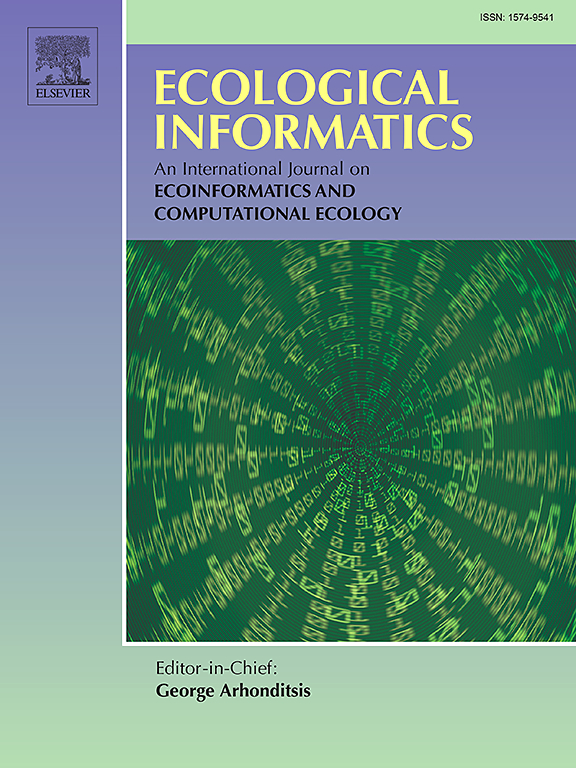Land-cover classification in Addo Elephant National Park: Analyzing the impact of variables, classifiers, and object-based approach
IF 5.8
2区 环境科学与生态学
Q1 ECOLOGY
引用次数: 0
Abstract
A comprehensive understanding of land-use and land-cover (LULC) dynamics is vital in steering effective conservation and management efforts, especially in ecologically rich regions like Addo Elephant National Park (AENP). Despite its importance, up-to-date LULC maps of AENP remain scarce, needing an in-depth investigation to aid conservation planning. Using Landsat time-series data, this study produced 30-m resolution LULC maps for the years 2002, 2014, and 2022, and examined changes within six LULC categories. Object-based classification was compared with a pixel-based approach, revealing the superior performance of the pixel-based approach. Two machine learning (ML) techniques, Random Forest (RF) and Support Vector Machines (SVM), were compared with a deep learning (DL) technique, UNet++. The land-cover classification process using ML algorithms involved experimentation with various predictor variables, including spectral bands, spectral indices, time-series data, and textural information. Spectral mixture analysis was performed, and the resulting fraction layers were used as independent variables in the models. The study identified RF as the preferred classification algorithm using the optimal combination of these variables, achieving high accuracy of 89.1 %, 91.2 %, and 91.9 % for the years 2002, 2014, and 2022, respectively. Variable importance analysis highlighted the consistent significance of elevation, slope, and the time-series of normalized difference indices. The final land-cover maps revealed grass as the predominant class both inside and outside AENP, followed by thicket within the park, and agriculture outside it. Land-cover change analysis indicated small changes (<3 %), primarily involving transitions between thicket and grass classes inside the park, and grass and agriculture outside.

阿多大象国家公园土地覆盖分类:变量、分类器和基于对象方法的影响分析
全面了解土地利用和土地覆盖(LULC)动态对于指导有效的保护和管理工作至关重要,特别是在阿多大象国家公园(AENP)等生态丰富的地区。尽管它很重要,但最新的AENP LULC地图仍然很少,需要深入的调查来帮助保护规划。利用Landsat时间序列数据,本研究制作了2002年、2014年和2022年的30米分辨率LULC地图,并检查了六个LULC类别的变化。将基于对象的分类方法与基于像素的分类方法进行了比较,揭示了基于像素的分类方法的优越性能。两种机器学习(ML)技术,随机森林(RF)和支持向量机(SVM),与深度学习(DL)技术UNet++进行了比较。使用ML算法的土地覆盖分类过程涉及各种预测变量的实验,包括光谱带、光谱指数、时间序列数据和纹理信息。进行光谱混合分析,所得馏分层用作模型中的自变量。该研究确定RF是使用这些变量的最佳组合的首选分类算法,在2002年,2014年和2022年分别达到89.1%,91.2%和91.9%的高精度。变量重要度分析突出了高程、坡度和归一化差异指数时间序列的一致性显著性。最终的土地覆盖地图显示,草地是AENP内外的主要类型,其次是公园内的灌木丛和公园外的农业。土地覆盖变化分析显示变化较小(< 3%),主要涉及公园内灌丛和草类之间的转变,以及公园外草和农业之间的转变。
本文章由计算机程序翻译,如有差异,请以英文原文为准。
求助全文
约1分钟内获得全文
求助全文
来源期刊

Ecological Informatics
环境科学-生态学
CiteScore
8.30
自引率
11.80%
发文量
346
审稿时长
46 days
期刊介绍:
The journal Ecological Informatics is devoted to the publication of high quality, peer-reviewed articles on all aspects of computational ecology, data science and biogeography. The scope of the journal takes into account the data-intensive nature of ecology, the growing capacity of information technology to access, harness and leverage complex data as well as the critical need for informing sustainable management in view of global environmental and climate change.
The nature of the journal is interdisciplinary at the crossover between ecology and informatics. It focuses on novel concepts and techniques for image- and genome-based monitoring and interpretation, sensor- and multimedia-based data acquisition, internet-based data archiving and sharing, data assimilation, modelling and prediction of ecological data.
 求助内容:
求助内容: 应助结果提醒方式:
应助结果提醒方式:


